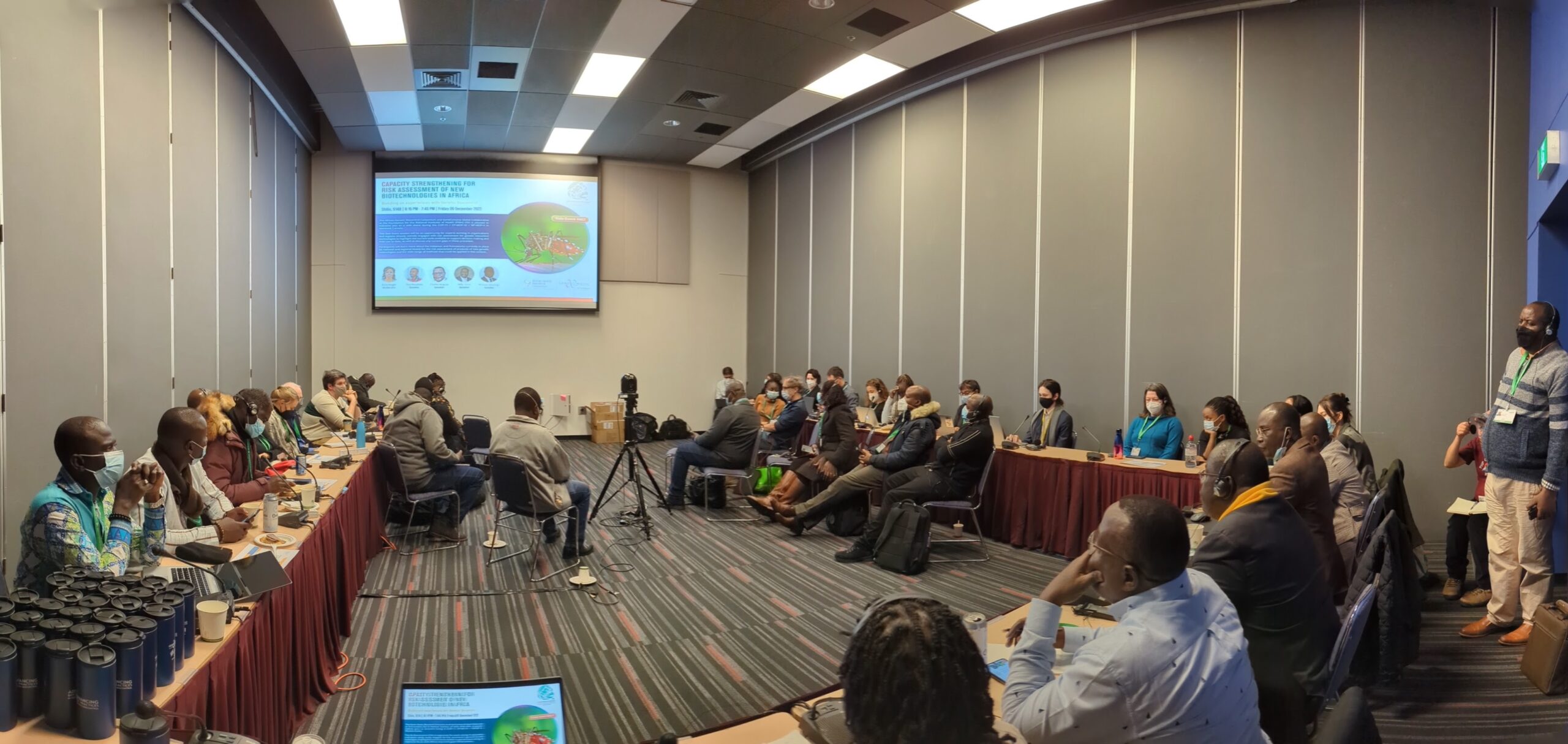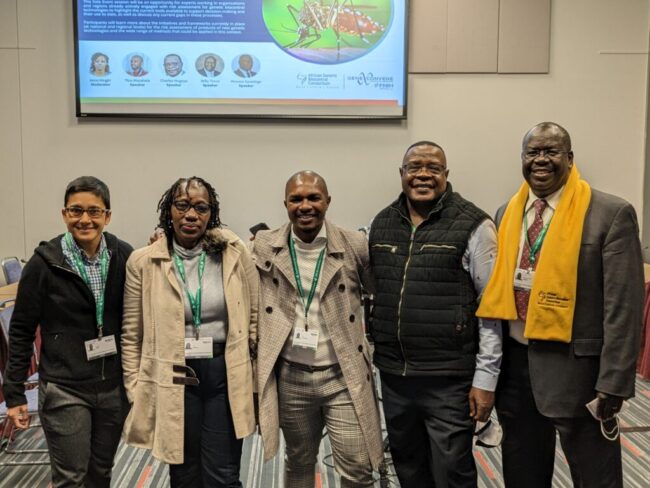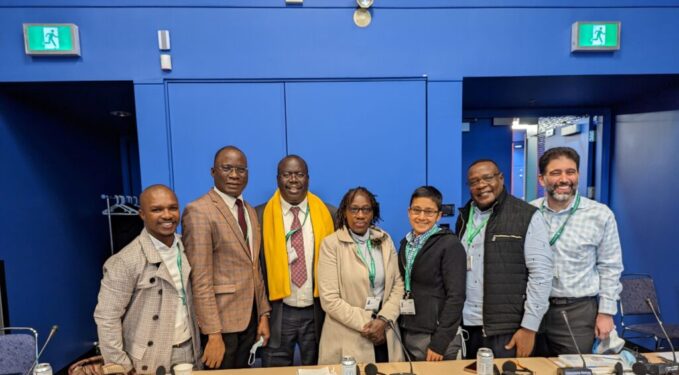COP 15 Side Event: Capacity Strengthening for Risk Assessment of New Biotechnologies in Africa – Building on Experiences with Genetic Biocontrol
Posted on December 16 2022

On 9th December 2022, the African Genetic Biocontrol Consortium in collaboration with GeneConvene Global Collaborative at the Foundation for the National Institutes of Health (FNIH) USA held a side event during the Fifteenth meeting of the Conference of the Parties (COP 15) in Montreal, Canada. The focus of this side event was on new and emerging technologies, which include advances in the fields of synthetic biology and biotechnology, have led to the development of a wide range of proposed applications of their resulting outputs.
As such, this side event brought together experts working in organizations and regions already actively engaged with risk assessment for genetic biocontrol technologies to highlight the current tools that are available to support decision-making and how these are being used, as well discuss as any current gaps in these processes. Participants learnt the initiatives and frameworks currently in place (at national and regional levels) for the risk assessment of products of new genetic technologies and how a wide range of methods might be applied in the context of genetic technologies. Specifically, this side event on risk assessment and risk management of living modified organisms (LMOs) supports SDG Target 3.d, which calls for strengthening capacities of developing countries for early warning, risk reduction, and management of national and global health risks.

The first presentation was given by Tlou Masehela from MORA Ecological Services & The Bee Effect on “Risk assessment in the African biotechnology arena: Methods, Experiences and Opportunities.” He started off by giving advancements and drawbacks in the testing and use of biotechnology products including existing huge variations across the African continent, regulatory environment, knowledge and skills, risks and concerns, ethical concerns, and political landscape. Risk assessment tools are used to support the regulatory and decision-making process. Identification of potential hazards and analyzing what could happen if a hazard occurs is an important aspect of risk management. An important aspect of Tlou’s presentation were the challenges and opportunities for risk assessment. For instance, the field of biotechnology is rapidly evolving, thus there are challenges new and emerging biotechnologies. Additionally, he mentioned that African countries lack behind in biosafety regulations and policies.
The next presentation was given by Charles Mugoya from Target Malaria on “Assessment tools for decision making: ESHIA and ERA – what are they and how do they differ?” He started off by defining Environmental, Social, Economic and Health Impact Assessment (ESHIA) in the context of new biotechnologies in Africa as a systematic process for predicting and evaluating potential social, economic, health and environmental impacts of a proposed project. He added that its main aim is to identify measures that will enable the project to meet the requirements and expectations of potentially impacted stakeholders and ensure compliance with applicable laws and regulations. It allows implementing potentially additional measures to enhance social or environmental performance not initially envisaged. Charles summarized by indicating that ESHIA is participatory, with a particular utility to examine and assess broad impacts (positive and negative) across environmental, social, economic and health domains.
Willy Tonui from the African Genetic Biocontrol Consortium made a presentation on “Knowledge and gaps on the various risk assessment methods in Africa.” He pointed out that risk assessment will be an essential element of the development and testing of gene drive-modified mosquitoes. For gene drive technologies, quantitative ecological risk assessment is recommended. In addition, an independent risk assessment from experts is ideal for informing developers of gene drive mosquitoes so as to build stakeholder confidence. On knowledge gaps, Willy mentioned that independent probabilistic quantitative risk assessment for release of GM mosquitoes in Africa is conducted by third party consultants based in Australia and others based out of Africa. As such, there is a lack of prior experience on Risk Assessment for new and emerging technologies. Some of the efforts made towards bridging risk assessment gaps in Africa are done by the Consortium and partners through webinars and training with a goal to establish a cohort of African individuals to access to a wider range of qualitative and quantitative risk assessment tools of emerging technologies including gene drive containing organisms such as mosquitoes.
Lastly, Moussa Savadogo drom AUDA-NEPAD gave a presentation on “Capacity strengthening for risk assessment of new biotechnologies in Africa – Building on experiences with genetic biocontrol – Role of AUDA NEPAD.” On risk assessment, Moussa mentioned that AUDA-NEPAD assists AU member states to draft or revise their biosafety laws with clear provisions for Risk Assessment, Risk Management, Risk Communication and decision making. Additionally, the body offers specialized training on risk assessment, technical assistance, and experience sharing among countries for risk assessment. AUDA-NEPAD values partnership and is engaged in multilateral mechanisms to address issues around emerging technologies.



After a successful side event some of the take home key messages include:
- A wide range of risk assessment tools, such as qualitative, semi-quantitative, and quantitative methods; and assessment types such as, SEA and ESHIA, may be useful in decision-making for research and development of new genetic and emerging technologies.
- African professionals and partner organizations are actively involved in building national and regional capacity for GMO risk assessments and decision-making processes.
- Additional risk assessment tools can support current efforts in various African countries to expand their existing regulatory frameworks and contribute to ongoing discussions under the auspices of the CBD.
